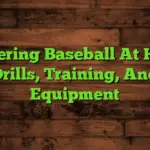Finding the right pair of baseball socks can significantly impact your performance and comfort on the field. This guide will help you navigate the world of baseball socks, exploring different features, materials, and brands to help you find the best baseball socks for comfort and durability. We’ll cover everything from sock length and material to cushioning and breathability, ensuring you’re equipped with the knowledge to make an informed choice. You’ll learn how to identify high-quality socks, understand the importance of proper fit, and discover top brands and models that consistently deliver both comfort and long-lasting wear.
Baseball socks are often made from a blend of materials to optimize performance. Cotton provides comfort and moisture absorption, while polyester enhances durability and moisture-wicking properties.
Nylon adds strength and elasticity, while merino wool offers superior temperature regulation and odor resistance. The optimal blend depends on your personal preferences and playing conditions. For example, a cotton-polyester blend is ideal for moderate weather, while a merino wool blend might be preferable for cooler temperatures.
Sock Length: Crew, Quarter, and Over-the-Calf
Finding the Right Height for Your Needs
Baseball socks come in various lengths: crew (ankle-height), quarter (mid-calf), and over-the-calf. Crew socks are lightweight and breathable, suitable for warm weather or players who prefer a less restrictive feel. Quarter socks offer a balance of comfort and support, covering most of the calf. Over-the-calf socks provide maximum protection and support, especially beneficial during intense gameplay or in colder weather. The best length ultimately depends on your personal preference and the level of support you require.
Cushioning and Support: Protecting Your Feet
The Importance of Arch Support and Padding
Proper cushioning and support are crucial for preventing blisters and discomfort during long games. Look for socks with reinforced heels and toes for added durability. Arch support helps maintain proper foot alignment and reduces fatigue. Some socks offer strategically placed padding in high-impact areas, minimizing friction and maximizing comfort. Consider your foot type and playing intensity when choosing the level of cushioning needed. For example, players with high arches might benefit from additional support in that area.
Breathability and Moisture-Wicking: Staying Dry and Comfortable
Preventing Sweat Buildup and Blisters
Breathability is essential for keeping your feet dry and comfortable, especially during intense physical activity. Moisture-wicking fabrics draw sweat away from your skin, preventing the buildup of moisture that can lead to blisters and discomfort. Look for socks made from materials like polyester or merino wool, which are known for their excellent moisture-wicking properties. Mesh panels or ventilation zones can also enhance breathability.
Durability: Finding Socks That Last
Reinforcements and Construction
Durable baseball socks are an investment that pays off in the long run. Look for socks with reinforced stitching in high-stress areas such as the heel and toe. The overall construction of the sock should be sturdy, with minimal loose threads or weak points. High-quality materials and meticulous craftsmanship are key indicators of durability. Consider reading reviews to gauge the longevity of different brands and models.
Fit and Sizing: Avoiding Discomfort and Performance Issues
Understanding Sock Sizes and Proper Fit
Proper fit is paramount for both comfort and performance. Socks that are too tight can restrict blood flow and cause discomfort, while socks that are too loose can bunch up and create friction. Refer to the manufacturer’s sizing chart to ensure you select the appropriate size. Try on socks before purchasing if possible, paying attention to the feel around the toes, heel, and arch.
Top Brands and Models: A Comparison
Reviewing Popular Choices
Numerous brands manufacture high-quality baseball socks. Some popular options include Nike, Under Armour, Adidas, and Mizuno. Each brand offers a range of styles and features, catering to various preferences and budgets. Consider reading reviews and comparing features before making your purchase. Look for reviews that highlight aspects like comfort, durability, and moisture-wicking.
Price vs. Quality: Finding the Right Balance
Balancing Cost and Performance
The price of baseball socks can vary considerably. While more expensive socks may offer superior materials and construction, it’s not always necessary to break the bank. Consider your budget and playing needs when making your decision. Often, a mid-range sock provides excellent quality and performance without exceeding your budget. Reading reviews often helps determine the value proposition of a particular sock.
Caring for Your Baseball Socks: Extending Their Lifespan
Washing, Drying, and Storage Tips
Proper care extends the lifespan of your baseball socks. Always wash your socks in cold water and air dry them to prevent shrinkage and damage. Avoid using harsh detergents or bleach, which can weaken the fabric. Store your socks in a cool, dry place, away from direct sunlight or moisture. Proper care will keep your socks looking and feeling their best for longer.
Baseball Socks for Specific Needs: Cleats and Turf Shoes
Addressing Different Footwear Choices
The type of footwear you use can influence the type of socks you need. Cleats often require thicker, more durable socks to protect your feet from abrasion. Turf shoes might benefit from lighter, more breathable socks. Consider the demands of your footwear when choosing the right socks to maximize comfort and protection.
The Importance of Proper Sock Maintenance for Preventing Foot Injuries
Addressing Blisters, Hot Spots, and Other Foot Problems
Investing in high-quality, well-fitting socks is crucial for preventing common foot problems. Properly maintained socks help prevent friction and moisture buildup, reducing the risk of blisters, hot spots, and other injuries. This can improve your overall performance and comfort on the field.
Finding the Right Fit: Addressing Different Foot Shapes and Sizes
Understanding Foot Anatomy and Sock Selection
Feet come in various shapes and sizes. Understanding your own foot type and selecting socks that cater to its unique needs can dramatically increase your comfort. Consider factors such as arch height, width, and length when choosing socks. Different manufacturers use various sizing standards, so comparing sizes between brands is essential.
Beyond the Basics: Advanced Features in Baseball Socks
Compression, Antimicrobial Properties, and More
Some baseball socks incorporate advanced features, such as compression technology, antimicrobial properties, and enhanced cushioning systems. Compression socks can improve circulation and reduce muscle fatigue. Antimicrobial properties help prevent odor-causing bacteria. Advanced cushioning systems offer targeted support to key areas of the foot.
The Role of Baseball Socks in Athletic Performance
Impact on Comfort, Injury Prevention, and Overall Gameplay
Baseball socks play a significant role in athletic performance. Comfortable, well-fitting socks prevent distractions, injuries, and improve overall gameplay. The correct socks allow for better circulation, preventing fatigue and aiding performance.
Buying Guide: Factors to Consider Before Purchasing Baseball Socks
A Checklist to Ensure Your Purchase is Right for You
Before buying baseball socks, consider your budget, preferred material, length, and desired level of cushioning and support. Read reviews, check sizing charts, and consider whether you need specific features like compression or antimicrobial properties.
Frequently Asked Questions
What are the most common materials used in baseball socks?
Common materials include cotton, polyester, nylon, and blends thereof. Cotton is comfortable but can retain moisture, while polyester and nylon are more moisture-wicking. Blends offer a combination of comfort and performance.
How do I determine the right size baseball socks for me?
Consult the manufacturer’s sizing chart, paying close attention to your foot length and width. If possible, try on socks before purchasing to ensure a proper fit.
What is the difference between crew, quarter, and over-the-calf baseball socks?
Crew socks are ankle-height, quarter socks are mid-calf, and over-the-calf socks extend higher up the leg. The choice depends on personal preference and the level of support needed.
How do I care for my baseball socks to extend their lifespan?
Wash them in cold water with a mild detergent, avoid bleach, and air dry them. Proper care will prevent shrinkage and damage, extending their lifespan.
Are compression socks beneficial for baseball players?
Compression socks can improve blood circulation, reduce muscle fatigue, and enhance performance. However, they may not be necessary for all players.
What should I look for in a durable baseball sock?
Look for reinforced stitching, particularly at the heel and toe. High-quality materials and strong construction are essential indicators of durability. Reviews often highlight the longevity of specific sock models.
Final Thoughts
Choosing the best baseball socks for comfort and durability is a personal decision. By carefully considering the factors outlined in this guide – material, length, cushioning, breathability, and durability – you can find the perfect pair to enhance your performance and comfort on the field. Remember to consider your foot type, playing style, and budget when making your selection. Prioritizing quality and proper fit will not only lead to greater comfort but also help prevent common foot injuries, allowing you to focus on what matters most: the game. Don’t hesitate to explore different brands and models until you find the pair that meets your specific needs. Happy sock hunting!





